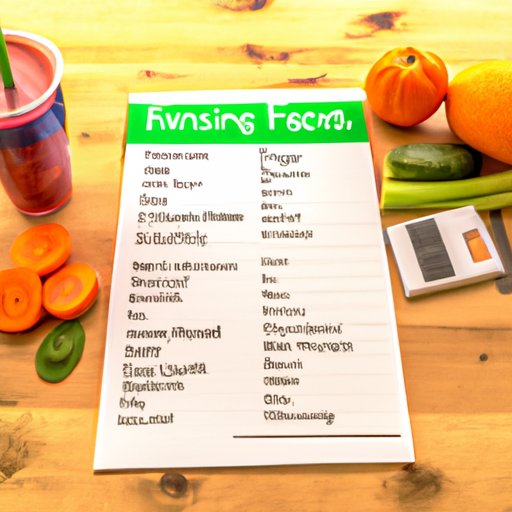
Introduction
When it comes to weight loss, many people are looking for quick results. While there is no magic pill to shed pounds overnight, there are several tried-and-true methods that can help you lose weight rapidly. In this article, we’ll explore five popular methods for losing weight quickly: HIIT, intermittent fasting, juice cleanses, low-carb diets, and mindful eating. Whether you want to jumpstart your weight loss journey or break through a plateau, these methods could be just what you need.
High-Intensity Interval Training
High-Intensity Interval Training, or HIIT, involves short bursts of intense exercise followed by periods of rest. The idea is to get your heart rate up and burn more calories in less time than traditional cardio.
The science behind HIIT is that it increases the body’s metabolic rate, both during and after exercise. This means you’ll continue to burn calories even after you’ve finished your workout. HIIT has also been shown to reduce waist circumference and body fat percentage, making it an effective method for weight loss.
Here are some sample workouts for beginners:
- 30 seconds of jumping jacks, followed by 30 seconds of rest. Repeat for 10 rounds.
- 20 seconds of push-ups, followed by 10 seconds of rest. Repeat for 8 rounds.
- 30 seconds of burpees, followed by 30 seconds of rest. Repeat for 10 rounds.
When starting a HIIT routine, it’s important to warm up properly and listen to your body. Start with shorter intervals and gradually increase the intensity and duration of your workouts. Remember to incorporate rest days and proper nutrition to support your body’s recovery.
Intermittent Fasting
Intermittent fasting involves cycling between periods of eating and periods of fasting. This method has gained popularity in recent years for its potential benefits for weight loss and overall health.
The science behind intermittent fasting is that it helps regulate insulin levels and promote fat burning. There are several types of intermittent fasting, including:
- 16/8 method: eating during an 8-hour window and fasting for the remaining 16 hours
- 5:2 method: eating normally for 5 days and restricting calories to 500-600 for 2 non-consecutive days
- Alternate-day fasting: alternating between eating normally and fasting every other day
When practicing intermittent fasting, it’s important to stay hydrated and eat nutrient-dense foods during your eating windows. It’s also helpful to plan your meals and snacks ahead of time to avoid overeating during eating periods. As with any diet, it’s important to listen to your body and adjust as needed.
Juice Cleanses
Juice cleanses involve consuming only fruit and vegetable juices for a set period of time, often 1-5 days. Advocates of juice cleanses claim that they can help detoxify the body and aid in weight loss.
While there is some evidence to suggest that juice cleanses can improve markers of gut health and inflammation, there are also potential drawbacks. Juice cleanses can be low in protein and fiber, which could lead to muscle loss and hunger. They can also be high in sugar and calories, which could counteract weight loss efforts.
If you decide to try a juice cleanse, it’s important to choose a reputable company or make your own juices using a variety of fruits and vegetables. It’s also recommended to ease into and out of a cleanse by gradually reducing and increasing solid foods. If you experience any negative side effects like dizziness or fatigue, stop the cleanse immediately.
Low-Carb Diets
Low-carb diets like Atkins and keto involve drastically reducing carbohydrates and increasing protein and fat intake. The idea is to put your body into a state of ketosis, where it burns fat for fuel instead of carbs.
The science behind low-carb diets is that they can reduce appetite and promote weight loss, as well as improve blood sugar levels and cholesterol levels. However, there are also potential drawbacks, including nutrient deficiencies and an increased risk of heart disease.
If you decide to try a low-carb diet, it’s important to focus on whole, nutrient-dense foods like vegetables, nuts, and lean protein sources. It’s also important to stay hydrated and replenish electrolytes, as the diuretic effect of the diet can lead to dehydration. As with any diet, it’s important to listen to your body and adjust as needed.
Mindful Eating
Mindful eating involves paying attention to your hunger and fullness cues, as well as enjoying the sensory experience of eating. This method can help you tune into your body’s needs and reduce mindless eating.
The science behind mindful eating is that it can lead to a reduced calorie intake and improved eating habits. By savoring each bite and eating slowly, you’ll be more likely to feel satisfied with smaller portions. Mindful eating can also help you choose healthier foods and overcome emotional eating triggers.
Here are some strategies for practicing mindful eating:
- Eat without distractions, such as TV or phone
- Chew slowly and savor the taste
- Pay attention to your body’s hunger and fullness signals
- Choose foods that nourish your body and make you feel good
By incorporating healthy, filling foods like fruits, vegetables, lean protein, and whole grains, you can create a sustainable mindful eating plan. It’s also important to avoid labeling foods as “good” or “bad” and instead focus on balance and moderation.
Conclusion
There are several methods for losing weight rapidly, and the key is to find the right approach for you. HIIT, intermittent fasting, juice cleanses, low-carb diets, and mindful eating are all effective methods with potential benefits and drawbacks. By combining healthy eating habits with regular exercise and self-care, you can achieve your weight loss goals in a sustainable way. For additional information and support, consider consulting with a registered dietitian or certified personal trainer.




